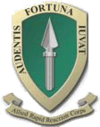Allied Rapid Reaction Corps
| Allied Rapid Reaction Corps | |
|---|---|
 | |
| Active | 2 October 1992 - Present |
| Country | and 16 other nations |
| Allegiance | and 16 others |
| Branch | and 16 others |
| Type |
|
| Part of |
|
| Garrison/HQ | Imjin Barracks, Innsworth |
| Motto(s) | Fortune favours the brave |
| Commanders | |
| Current commander |
Lieutenant General Tim Radford, Commander (COMARRC) Major General Roberto D'Alessandro, Deputy Commander (DCOMARRC) |
The Allied Rapid Reaction Corps, (ARRC) is a North Atlantic Treaty Organisation High Readiness Force (Land) Headquarters ready for deployment worldwide within five to thirty days.
History
The ARRC was created on 2 October 1992 in Bielefeld based on the former British I Corps (or I (BR) Corps).[1] It was originally created as the rapid reaction corps sized land force of the Reaction Forces Concept that emerged after the end of the Cold War, with a mission to redeploy and reinforce within Allied Command Europe (ACE) and to conduct Petersberg missions out of NATO territory. The first commander, appointed in 1992 was General Sir Jeremy Mackenzie.[2]
From 1994 the ARRC was based in the Rheindahlen Military Complex, Germany. It commanded the Land Forces of NATO's first ever deployment as part of the IFOR operation in Bosnia in 1995/6 and was again deployed as the headquarters commanding Land Forces during the Kosovo War in 1999.[3]
Since 2002 however the HQ has been re-roled (with five other corps HQs of other NATO nations) as a High Readiness Force (Land) HQ (HRF(L)) with a broader mission. The formation HQ is under Operational Command of Supreme Allied Commander, Europe (SACEUR). The ARRC has a national Force Pool of Combat, Combat Support and Combat Service Support units with which to train and execute its mission. However, in reality COMARRC commands no forces until he receives an Activation Order from SACEUR. On receipt of ACTORD, forces from troop contributing nations, generated through the NATO Force Generation process are passed into his Operational Command for the duration of the operational deployment.
Although the corps is commanded by a British Army lieutenant-general, the corps is no longer a purely British formation. The UK is the 'framework nation' and provides about 80% of the funding and 60% of the staff for the HQ. The remaining 40% of the staff are made up of a further 14 Partner Nations.
ARRC took command of the International Security Assistance Force in Afghanistan on 4 May 2006 and then relocated from Rheindahlen to Imjin Barracks, outside Gloucester in England, in 2010[4] before deploying to support the ISAF Joint Command Headquarters in Afghanistan in 2011.[5]
Structure
Currently (September 2015) the structure of HQ ARRC is as follows:[6]
- Commander (UK),
- Deputy Commander (Italy),
- Chief of Staff (UK),
- Central Staff - Staff Support (Denmark),
- Operations Division - G35 and G5 (USA),
- Support Division - G1, G4 and G8 (UK),
- Intelligence G2 (UK),
- G3 (France),
- Joint Fires and Influence Branch (UK),
- Command Information Systems - G6 (UK),
- Training and Security Force Assistance - G7 (UK),
- Engineers and Civil Military Integration - G9 (UK),
- ARRC Enabling Command (Germany).
The deployable headquarters infrastructure and communications for HQ ARRC is provided by the 1st Signal Brigade under the Army 2020 concept.[7]
Recent Commanders
Recent commanders have included:[8]
- 1992–1994: Lieutenant General Jeremy Mackenzie
- 1994–1997: Lieutenant General Michael Walker
- 1997–2000: Lieutenant General Mike Jackson
- 2000–2002: Lieutenant General Christopher Drewry
- 2002–2005: Lieutenant General Richard Dannatt
- 2005–2007: Lieutenant General David Richards
- 2007–2011: Lieutenant General Richard Shirreff
- 2011–2013: Lieutenant General James Bucknall
- 2013–2016: Lieutenant General Timothy Evans
- 2016–present: Lieutenant General Timothy Radford
See also
- Response Force Task Group
- UK Joint Expeditionary Force
- Combined Joint Expeditionary Force
- Joint Rapid Reaction Force
References
- ↑ Challenges to NATO
- ↑ Blue Hackle
- ↑ "British general scheduled to lead NATO's Kosovo peacekeeping force". Baltimore Sun. 5 June 1999. Retrieved 14 July 2013.
- ↑ UK Parliament Statement, URL retrieved May 17, 2008
- ↑ UK MOD website
- ↑ About ARRC: Structure Archived 14 June 2012 at the Wayback Machine.
- ↑ Army 2020 Report
- ↑ Army Commands Archived 5 July 2015 at the Wayback Machine.
External links
Coordinates: 51°10′35″N 6°19′18″E / 51.17639°N 6.32167°E